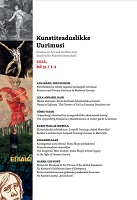Hümn inetusele. Kurja õied Eesti dekadentlikus kunstis
Hymn to Ugliness. The Flowers of Evil in Estonian Decadent Art
Author(s): Lola Annabel KassSubject(s): Cultural history, Visual Arts, Pre-WW I & WW I (1900 -1919), Interwar Period (1920 - 1939), History of Art
Published by: Eesti Kunstiteadlaste Ühing
Keywords: flower of evil; Estonian art; decadent art;
Summary/Abstract: The words fleur and mal in the title of Charles Baudelaire’s collection of poems Les Fleurs du Mal (1857) have broad meanings and connotations, and appear in visualisations of the figure of the flower of evil. In French, mal means sickness, illness, harm, trouble and pain, as well as evil, including personified evil. The word fleur means ‘flower’ and ‘blossom’, the latter of which is more ambiguous. While ‘flower’ is primarily associated with a flowering plant, the word ‘blossom’ also covers the previous meaning, but it does not have to be a blossoming flower. For example, there are blossoms on apple trees too (see Ills 1 and 6). The blossom still marks the blossoming or spread and vitality of mal, which can also be manifested in unusual beauty (from the conservative viewpoint). A blossom is also the consequence of the blossoming of mal.
Journal: Kunstiteaduslikke Uurimusi
- Issue Year: 31/2022
- Issue No: 01+02
- Page Range: 42-76
- Page Count: 35
- Language: Estonian
- Content File-PDF

